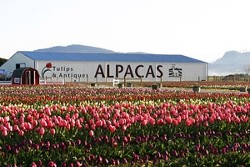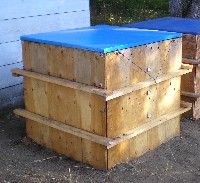Alpaca Manure Composting
The alpaca is a ruminent with three stomachs. It converts grass and hay to energy very quickly, eating far less (as a percentage of its body weight) than other farm animals. Alpaca manure is lower in organic matter content than the manure from most other barnyard livestock (cows, horses, goats and sheep) but still has enough to improve soil texture and water-holding capacity. This lower organic content allows alpaca manure to be spread directly onto plants without burning them. It is the decomposition of organic matter content of the manure that indicates their efficient digestion system.
The nitrogen and potassium content of alpaca dung is comparatively high, an indication of good fertilizer value. Nitrogen, phosphorus and potassium are the major plant nutrients. Phosphorus is relatively low as in most livestock manure. The calcium and magnesium content is about average. South American Indians use the alpaca waste for fuel, and local gardeners find the alpaca's rich fertilizer perfect for growing fruits and vegetables. A herd of alpacas consolidates its waste in one or two spots in the pasture, thereby controlling the spread of parasites and making it easier to collect and compost their fertilizer.
Alpacas of Misty Ridge
Located in Mt. Vernon, Washington, Misty Ridge Alpaca Farm is situated in the heart of tulip country. As I passed through the area last summer, I stopped by and spoke with the owners, John and Shannon Ellis, about their alpaca manure and asked if I could pick up a trailer load for testing at home. Given the volume of manure generated by their 300 Huacaya and Suri alpacas, they were more than happy to accommodate my request.
The following Saturday, I showed up at the appointed time with my trailer in tow and their herd manager, Miguel, loaded me up. As he did, he kept asking "Are you sure you have enough?" In my zeal to get started with my next manure test, I took a bit more than my trailer could safely hold, proving that alpaca manure is quite heavy when wet.
This manure was kept under a covered shed roof out of the northwest rainy weather. Even during the summer months it had a very interesting consistency, ranging from hard, whitish dry "pebbles" to a wet, deep green "paste" with scattered straw and hay intermixed. The odor was quite different from that of other farm animals, giving new meaning to the word "distinctive". As I headed down the highway, I received more than a few quizzical looks as steam poured out from beneath the tarp.
Composting Alpaca Manure in O2Compost Micro-Bin
With my first shovelful, I immediately realized that alpaca manure definitely needs to be mixed with some type of a bulking agent to improve its porosity. It was simply too heavy and dense to allow air to flow evenly through the mix. Fortunately, I had just completed composting a batch of horse manure and sawdust so I used this as my amendment. To mix the compost and manure together, I spread out a large tarp and placed approximately 1 foot of compost on it. Following this, I shoveled roughly the same amount of alpaca manure onto the compost and then I turned the two together. Shovel work is never very efficient, but this job would be relatively easy with a farm tractor and front-end loader.
 Once mixed, I loaded one of my micro-bin test units to within 6 inches of the top. I then topped the bin off with finished compost and covered it with a plastic tarp and wood frame cover. Following this, I set the timer to turn the blower on for 30 seconds every 30 minutes and I inserted three 20-inch long temperature probes at 18", 24" and 30" above the ground.
Once mixed, I loaded one of my micro-bin test units to within 6 inches of the top. I then topped the bin off with finished compost and covered it with a plastic tarp and wood frame cover. Following this, I set the timer to turn the blower on for 30 seconds every 30 minutes and I inserted three 20-inch long temperature probes at 18", 24" and 30" above the ground.
By the next morning (~16 hours), the pile temperature came up to 155°F throughout the bin, a clear indication that everything was progressing as expected. Bin temperatures stayed high for teh better part of 3 weeks and then trailed off slowly to ambient temperatures by the end of 6 weeks. At first, the odor was strong but not unpleasant and within a few days there was barely any detectable odor at all. Although there were clumps of alpaca "paste" in the initial mix, these inclusions broke down quite well, yielding a finished compost that has a pleasant fragrance. With a high nutrient content and no weed seeds, this compost will be a welcome addition to my vegetable garden this coming spring.